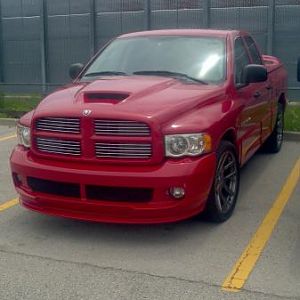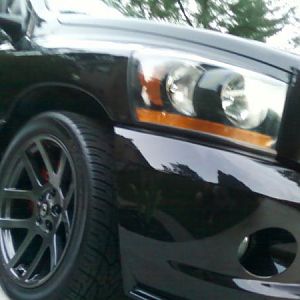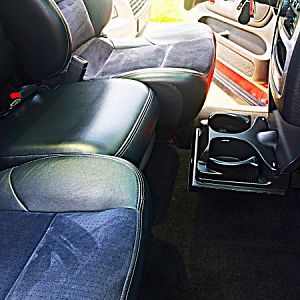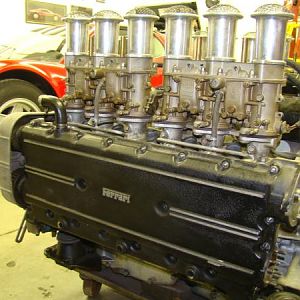Has anyone tried one or given it consideration? I would imagine there is plenty of horsepower to be made by increasing the spark plug gaps as well as smoother drivability at idle and around town. Kenne Bell offers it for both Hemi's, I'm assuming we could make it work on our trucks.
You are using an out of date browser. It may not display this or other websites correctly.
You should upgrade or use an alternative browser.
You should upgrade or use an alternative browser.
Kene Belll Boost a Spark
- Thread starter blackviper
- Start date
I assume Tony covered the spark boost with his Venom coil paks?...
I know Tony's coils are an improvement over stock but I don't think they would allow us to gap our plugs at .060.
Here is some info on the Boost a Spark.
Recommended for high cylinder pressure (turbocharged, supercharged, nitrous). The ignition system market has changed. The new domestic and import engines no longer use a distributor with one coil. Instead, there are multiple coils - one (1) for each cylinder. Some engines even have a coil mounted on the individual spark plugs. CD ignitions use the high voltage "short spark" principle whereas the BOOST-A-SPARK™ incorporates the preferred higher energy "long spark" (2500 microseconds vs. 200 for CD's.
Kenne Bell, The Innovators, has done it again! The FIRST high energy non CD system designed specifically for the new 4, 6, 8, 10 and 12 cylinder engines. And it's cockpit adjustable from 0-50% to handle any boost or rpm. You are in total control. The revolutionary adjustable Kenne Bell BOOST-A-SPARK™ merely taps in on one (1) wire and supplies all the energy your engine needs. All stock modern day engines have great ignition systems for start up, idle, part throttle, fuel economy etc. It's at WIDE OPEN THROTTLE where they're marginal. We activate our hot ignition only where it's really needed - at wide open throttle or in boost. In fact, it produces so much energy you may have to turn it down if the plug wires aren't in good shape. And it works equally well on ALL engines, not just the "coil" engines.
Forget the rhetoric and magazine ads and let's tell it like it really is. Never buy an ignition system for your late model "coil" vehicle because you think it will make more HP, help start ups, increase throttle response or improve fuel economy. It will not. You add an ignition system to guarantee it wll fire at higher rpm or boost levels. The Cobra's ignition (see below) was not igniting all the fuel mixture at 8 psi above 2500 rpm. We activated the ™at 3 psi and made 50HP.
The Boost-A-Spark came through with flying colors, as the engine never missed a beat, even with 8 psi of boost and the plug gap set at .100.
Muscle Mustangs & Fast Fords FEATURES THAT MAKE BOOST-A-SPARK™ SUPERIOR TO ALL OTHER IGNITIONS• Adjustable from 0-50% (13.5 - 20 volts).
• Increases spark energy - ALL 12 VOLT IGNITION SYSTEMS. Highest voltage of any ignition system concept.
• New Kenne Bell "Long Spark" Technology increases AND regulates voltage. NOT a CD with an inherently "short spark."
• More energy than CD systems. Over 2 amps at the plug (10 times more than OEM and 4 times more than other aftermarket ignition systems).
• Eliminates engine misfire under boost or high load.
• Ideal for supercharged, turbocharged and nitrous applications.
• Will fire spark plugs with up to .100" gap and 30 psi boost. 2500 microseconds vs. 200 for CD's.
• Regulates ignition voltage within .1 volt, regardless of battery voltage.
• Allows wider plug gaps for MORE POWER. Other ignition systems must run closer plug gaps.
• Automatically adjusts spark energy to meet engine requirements i.e. rich, lean, supercharged, high compression etc.
• Two (2) models. Supercharged / Turbocharged or Normally Aspirated. Pressure or vacuum switch included.
• Attractive red anodized extruded aluminum weatherproof case.
• Developed on the Kenne Bell Dyno.
• Easy to install. Just connect to primary coil wire.
Here is some info on the Boost a Spark.
Recommended for high cylinder pressure (turbocharged, supercharged, nitrous). The ignition system market has changed. The new domestic and import engines no longer use a distributor with one coil. Instead, there are multiple coils - one (1) for each cylinder. Some engines even have a coil mounted on the individual spark plugs. CD ignitions use the high voltage "short spark" principle whereas the BOOST-A-SPARK™ incorporates the preferred higher energy "long spark" (2500 microseconds vs. 200 for CD's.
Kenne Bell, The Innovators, has done it again! The FIRST high energy non CD system designed specifically for the new 4, 6, 8, 10 and 12 cylinder engines. And it's cockpit adjustable from 0-50% to handle any boost or rpm. You are in total control. The revolutionary adjustable Kenne Bell BOOST-A-SPARK™ merely taps in on one (1) wire and supplies all the energy your engine needs. All stock modern day engines have great ignition systems for start up, idle, part throttle, fuel economy etc. It's at WIDE OPEN THROTTLE where they're marginal. We activate our hot ignition only where it's really needed - at wide open throttle or in boost. In fact, it produces so much energy you may have to turn it down if the plug wires aren't in good shape. And it works equally well on ALL engines, not just the "coil" engines.
Forget the rhetoric and magazine ads and let's tell it like it really is. Never buy an ignition system for your late model "coil" vehicle because you think it will make more HP, help start ups, increase throttle response or improve fuel economy. It will not. You add an ignition system to guarantee it wll fire at higher rpm or boost levels. The Cobra's ignition (see below) was not igniting all the fuel mixture at 8 psi above 2500 rpm. We activated the ™at 3 psi and made 50HP.
The Boost-A-Spark came through with flying colors, as the engine never missed a beat, even with 8 psi of boost and the plug gap set at .100.
Muscle Mustangs & Fast Fords FEATURES THAT MAKE BOOST-A-SPARK™ SUPERIOR TO ALL OTHER IGNITIONS• Adjustable from 0-50% (13.5 - 20 volts).
• Increases spark energy - ALL 12 VOLT IGNITION SYSTEMS. Highest voltage of any ignition system concept.
• New Kenne Bell "Long Spark" Technology increases AND regulates voltage. NOT a CD with an inherently "short spark."
• More energy than CD systems. Over 2 amps at the plug (10 times more than OEM and 4 times more than other aftermarket ignition systems).
• Eliminates engine misfire under boost or high load.
• Ideal for supercharged, turbocharged and nitrous applications.
• Will fire spark plugs with up to .100" gap and 30 psi boost. 2500 microseconds vs. 200 for CD's.
• Regulates ignition voltage within .1 volt, regardless of battery voltage.
• Allows wider plug gaps for MORE POWER. Other ignition systems must run closer plug gaps.
• Automatically adjusts spark energy to meet engine requirements i.e. rich, lean, supercharged, high compression etc.
• Two (2) models. Supercharged / Turbocharged or Normally Aspirated. Pressure or vacuum switch included.
• Attractive red anodized extruded aluminum weatherproof case.
• Developed on the Kenne Bell Dyno.
• Easy to install. Just connect to primary coil wire.
Sounds like some really good benifits with the Boost a Spark Jorge,says they have it for 10cylinders??
Niz
Full Access Member
Interesting question...
What's interesting is that Kenne Bell made 50 more horsepower by using it at only 8psi of boost.
What's interesting is that Kenne Bell made 50 more horsepower by using it at only 8psi of boost.
Yes that is! And it helps eliminate detonation! Any idea on what it's worth?
I'm going to give them a call today to get some more details and listen to their recommendations. By any chance, do you remember what the spark plug gap is on the Roe setup?
Never mind. I did a search and found the gaps are supposive to be set at 35.
Never mind. I did a search and found the gaps are supposive to be set at 35.
LOL,I was just going to say .035:rock:
Yes that is! And it helps eliminate detonation! Any idea on what it's worth?
If it eliminates/reduces detonation in these engines.....it is PRICELESS.
Nice l-o-n-g duration spark. That can also bring the part-throttle, low-end torque out to play.
Last edited:
I spoke to Kenne Bell today and they said the only real benefit would be to control or prevent spark plug blow out. I would think there should be more to it than that. If we increase the discharge capacity of our ignition, there has to be more power and torque to be made.
Ronnie, am I being over ambitious with my thought process?
These can be purchased on Ebay for $250.00 or I believe directly from Kenne Bell for $275.00.
Ronnie, am I being over ambitious with my thought process?
These can be purchased on Ebay for $250.00 or I believe directly from Kenne Bell for $275.00.
Last edited:
I spoke to Kenne Bell today and they said the only real benefit would be to control or prevent spark plug blow out. I would think there should be more to it than that. If we increase the discharge capacity of our ignition, there has to be more power and torque to be made.
Ronnie, am I being over ambitious with my thought process?
It makes sense Jorge.
I spoke to Kenne Bell today and they said the only real benefit would be to control or prevent spark plug blow out. I would think there should be more to it than that. If we increase the discharge capacity of our ignition, there has to be more power and torque to be made.
Ronnie, am I being over ambitious with my thought process?
These can be purchased on Ebay for $250.00 or I believe directly from Kenne Bell for $275.00.
Remember, if a plug requires 38,450 volts to fire (for example) and the ignition system CAN PROVIDE the 38,450 volts, the plug will fire. If the plugs need more for some reason and the ignition system has a voltage reserve, that is a good thing. The ignition system will keep on firing the plugs until...
As plugs wear, the voltage required to fire them goes up. What happens then, is a morbid downward spiral because now the plug's firing tip is worn and is perhaps firing weaker than normal; and actually LATER than it should. In effect, the timing of that cylinder, or cylinders, is too late (retarded). Power and gas mileage start to both drop.
Fortunately, modern ignition systems have enough energy to light a small town and rarely will a cylinder actually go into a dead misfire condition in "normal" performance use.
But it is still important to change plugs in these engines fairly often. A plug doesn't have to be in misfire mode to be costing you power and mileage.
As mentioned in the article, CD ignition systems have a high intensity albeit SHORT duration spark. That system (obviously), will light a mixture. If for some reason, the flame goes out or tries to go out (for whatever the reason) an engine can't make make optimum power. In the case of CD ignition, it has a SHORT time to do it's thing. A longer duration spark or M.S.D. systems have the capacity to fire again and make sure the fire stays lit if there is an issue in that cylinder.
The design of a combustion chamber is part of the key. Without mentioning any particular brands, some combustion chambers are MUCH better in this area than others. Add cylinder pressure via forced induction, a higher static compression ratio to a cylinder head that already has "issues" and you are compounding the problem.
It is physically harder for an electric spark to jump a gap and light a fire under high(er) cylinder pressure conditions; like when forced induction is added or comparable mods to build more pressure than stock. So, the gap often needs to be reduced by the installer until a sweet-spot is found.
Regardless: Incomplete combustion, FOR WHATEVER THE REASON is lost power, it's that simple.
An ignition system that packs a whallop and has a long-duration spark may indeed allow that engine to produce more power. The parts work hard to bring a nice mixture into the cylinder with the hopes of building (high) cylinder pressure when it is lit. It is a shame when all of those components are let down by an inadequate ignition system.
I tend to gap plugs as wide as possible as it starts a larger flame front burning. And that is what it is, a BURN. A nice burn that starts with the spark plug, travels throughout the combustion chamber (which of course the piston is also part of that chamber at this time) and produces torque from that energy.
Detonation is often caused when the mixture is ignited by something else in the chamber (a hot chunk of carbon, for example, but there are MANY other causes) and then TWO flame fronts collide (one by the actual spark plug and the second by something else) and serious damage is often right behind..due to mechanical shock and heat.
Sorry, but I am out of time right now..
Hope this helps.
Ronnie
Last edited:
Thanks for the detailed explanation Ronnie. It seems that at the very least, it would be a good insurance policy at higher boost levels.
Excellent detail Ron!
Support Us
Become A Supporting Member Today!





